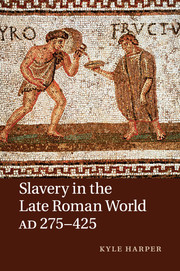Book contents
- Frontmatter
- Contents
- List of tables
- Acknowledgments
- PART I THE ECONOMY OF SLAVERY
- PART II THE MAKING OF HONORABLE SOCIETY
- Introduction
- 5 Semper timere: the aims and techniques of domination
- 6 Self, family, and community among slaves
- 7 Sex, status, and social reproduction
- 8 Mastery and the making of honor
- PART III THE IMPERIAL ORDER
- CONCLUSION
- APPENDIXES
- Bibliography
- Index
7 - Sex, status, and social reproduction
Published online by Cambridge University Press: 05 August 2011
- Frontmatter
- Contents
- List of tables
- Acknowledgments
- PART I THE ECONOMY OF SLAVERY
- PART II THE MAKING OF HONORABLE SOCIETY
- Introduction
- 5 Semper timere: the aims and techniques of domination
- 6 Self, family, and community among slaves
- 7 Sex, status, and social reproduction
- 8 Mastery and the making of honor
- PART III THE IMPERIAL ORDER
- CONCLUSION
- APPENDIXES
- Bibliography
- Index
Summary
SLAVERY AND SEXUAL EXPLOITATION
The rhetorical talent of John Chrysostom derived not least from his intuitive sense of where he stood vis-à-vis his audience, an awareness of the distance between his claims and prevailing opinion. It was a skill he needed as he led his congregation through the logic of Paul's teaching that marriage was acceptable “on account of fornications,” since it was “better to marry than to burn.” Chrysostom started his discussion on perfectly traditional grounds. Marriage was instituted for two reasons: the procreation of children and sexual self-control. For the Romans, marriage was defined by reproductive intent, and marriage contracts explicitly declared that a union was intended to create children. Chrysostom, though, quickly tried to undermine this primary purpose of marriage: the earth was full and in no need of additional bodies. Moreover, in the post-resurrection age, the promise of eternal life nullified the need to live through future generations. This left only one purpose for marriage. Paul was right: marriage was a bulwark against sexual sins. Switching subtly from the ancient code of “self-control” to the Christian vocabulary of sin, Chrysostom went completely beyond his audience's expectations. It was wrong for a married man to have sex, even with prostitutes or slaves. “What I am saying is illogical – but it's true.”
- Type
- Chapter
- Information
- Slavery in the Late Roman World, AD 275–425 , pp. 281 - 325Publisher: Cambridge University PressPrint publication year: 2011



